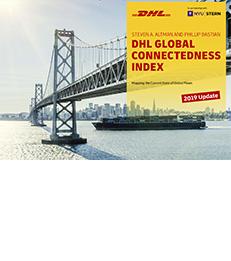Press Releases
DHL Global Connectedness Index: Globalization Holding Up Under Pressure
—

- The Index retreated modestly last year, pulled down by weak capital flows
- Trade remained resilient during 2018, but tensions are taking a toll in 2019
- Overall, the world is still more connected than at almost any other point in history
DHL and NYU Stern School of Business today released the 2019 update of the DHL Global Connectedness Index (GCI), which highlights key developments in international flows of capital, trade, information, and people. The new report shows that shrinking international capital flows caused global connectedness to dip slightly in 2018. However, despite strong headwinds in global geopolitics and trade, the GCI stayed close to its record high of 2017. The world remains more connected than at almost any other point in history, with no signs of a broad reversal of globalization so far.
“International exchange empowers people and businesses around the world to collaborate and seize new opportunities,” comments John Pearson, CEO of DHL Express. “While current geopolitical tensions could seriously disrupt global connectedness, this 2019 update finds that most international flows have remained surprisingly resilient so far. Ultimately, what we’re seeing today is the evolution of globalization, not its decline. Decision-makers need to be careful to not overreact to strong rhetoric or headlines.”
This update of the DHL Global Connectedness Index was calculated based on more than 3.5 million data points on country-to-country-flows. It provides full coverage from 2001 to 2018, along with partial analysis of the first half of 2019. The report also features a deep dive into the U.S.-China trading relationship, tracing the sharp decline in U.S.-China trade, as well as an examination of recent claims that globalization is giving way to regionalization.
“Our analysis does not confirm a robust regionalization trend. Instead, we see that the average distance across which countries trade has held steady since 2012,” explains Steven A. Altman, Senior Research Scholar at the NYU Stern School of Business and lead author of the DHL Global Connectedness Index. “While fraying relations between major economies could lead to a fracturing along regional lines, such a shift has not yet conclusively taken place.”
Trade and capital flows: lower, but no sign of a collapse
As the GCI update shows, trade flows continued to intensify through the early stages of the U.S.-China trade war in 2018. However, this strength did not extend into 2019. In the first half of this year, the share of global output traded across national borders fell. While trade volume growth is likely to remain positive this year, it is not expected to keep pace with GDP growth. Nonetheless, current forecasts suggest that trade intensity is on track for only a modest decline through 2020.
Capital was the only pillar of the index that declined in 2018. In fact, the pullback in global connectedness was entirely driven by shrinking international capital flows, specifically foreign direct investment (FDI) and portfolio equity investment. While early capital flow data for 2019 suggest some stabilization, a robust recovery on these metrics remains elusive. However, a large part of the recent FDI drop was due to U.S. tax policy changes, which have prompted U.S. multinationals to repatriate earnings held abroad. This suggests that fundamentals may be stronger than they appear, with no broad retreat from corporate globalization underway.
Global information and people flows: still advancing
The globalization of information flows continues to progress, but available measures point to a possible slowdown. While growth of international communications has typically far outpaced the growth of domestic communications since at least the early 2000s, recent data suggest that both are now growing at more similar rates. Global people flows also continue to advance. Outbound travel from emerging economies and liberalization of tourist visa requirements have given international tourism a significant boost. Despite public policy controversies, international migration also continues to grow.
Domestic business activity still dominates
Looking ahead, the 2019 update notes that all four flows measured by the DHL Global Connectedness Index— trade, capital, information and people—are currently running up against powerful headwinds. Rising barriers and uncertainty about future openness are starting to carry significant costs. At the same time, a survey on globalization perceptions reveals that many people do not realize how limited global connectedness actually is. While the world is more connected than at almost any previous point in history, most business still takes place within rather than across national borders. The report highlights how such exaggerated perceptions of globalization can lead to distorted decision-making in business and an underestimation of the significant potential available from further increases in global connectedness.
To learn more, please visit the DHL Global Connectedness Index page.
